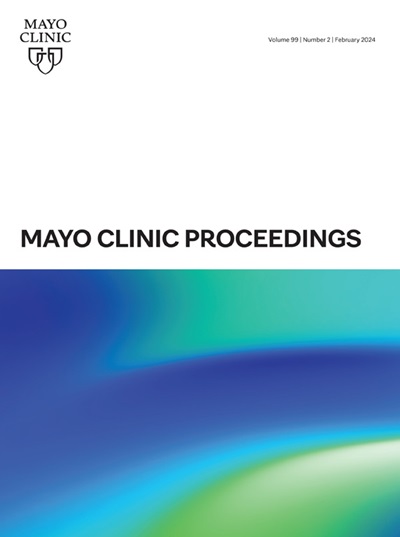Bias Experiences and Burnout: A Multispecialty, Cross-Sectional Survey of Residents and Fellows at a Multisite US Academic Medical Center
IF 6.9
2区 医学
Q1 MEDICINE, GENERAL & INTERNAL
引用次数: 0
Abstract
Objective
To explore associations of bias frequency, sources, and types with burnout in a large, multispecialty sample of residents and fellows and to determine whether and how odds of burnout change after adjustment for bias experiences in multiple demographic subgroups.
Methods
Trainees in graduate medical education programs at Mayo Clinic sites were surveyed between October 12, 2020, and November 22, 2020. Survey items measured personal experiences with bias (frequency, sources, types), burnout (2 Maslach Burnout Inventory items), and demographic characteristics (age, gender, race/ethnicity, lesbian-gay-bisexual-transgender-queer-nonbinary-other identification, disability, socioeconomic background, year in school, specialty). The χ2 test and logistic regression analyses examined relationships between variables.
Results
Of 1825 trainees surveyed, 942 (52%) from 77 programs responded. Overall, 16% (137/881) of respondents reported 1 or more personal bias experiences. Trainees reporting bias experiences weekly or more often had markedly higher odds of burnout in adjusted analyses (odds ratio [OR], 8.00; 95% CI, 2.68 to 23.89; P<.001). Bias from education leaders/staff, fellow learners, and faculty was independently associated with burnout, whereas bias from patients/companions and other staff/employees was not. Trainees with a disability (OR, 3.16; 95% CI, 1.05 to 9.53; P=.04) and trainees from a low-income background (OR, 1.53; 95% CI, 1.03 to 2.26; P=.03) had higher odds of burnout in unadjusted analyses, but these associations were no longer statistically significant after adjustment for bias frequency.
Conclusion
Self-reported bias experiences relate strongly to trainee burnout. Some bias sources may be more strongly associated with burnout than others. More frequent bias experiences could account, at least in part, for higher odds of burnout in some demographic subgroups.
偏见经历和职业倦怠:一项对美国多地点学术医疗中心住院医师和研究员的多专业横断面调查。
目的:在一个大型的、多专业的住院医师和研究员样本中,探讨偏倚频率、来源和类型与职业倦怠的关系,并确定在多个人口统计亚组中调整偏倚经历后,职业倦怠的几率是否以及如何变化。方法:在2020年10月12日至2020年11月22日期间,对梅奥诊所医学研究生教育项目的学员进行调查。调查项目测量了个人经历的偏见(频率、来源、类型)、倦怠(2个Maslach倦怠量表项目)和人口特征(年龄、性别、种族/民族、女同性恋、男同性恋、双性恋、跨性别、酷儿、非二元性认同、残疾、社会经济背景、上学年限、专业)。χ2检验和逻辑回归分析检验了变量之间的关系。结果:在接受调查的1825名学员中,来自77个项目的942人(52%)做出了回应。总体而言,16%(137/881)的受访者报告了一次或更多的个人偏见经历。校正分析显示,每周或更频繁报告偏倚经历的受训者倦怠的几率明显更高(优势比[or], 8.00;95% CI, 2.68 ~ 23.89;结论:自我报告的偏见经历与受训人员的职业倦怠密切相关。一些偏见来源可能比其他来源更容易导致倦怠。更频繁的偏见经历至少在一定程度上可以解释某些人口统计亚组中更高的倦怠几率。
本文章由计算机程序翻译,如有差异,请以英文原文为准。
求助全文
约1分钟内获得全文
求助全文
来源期刊

Mayo Clinic proceedings
医学-医学:内科
CiteScore
16.80
自引率
1.10%
发文量
383
审稿时长
37 days
期刊介绍:
Mayo Clinic Proceedings is a premier peer-reviewed clinical journal in general medicine. Sponsored by Mayo Clinic, it is one of the most widely read and highly cited scientific publications for physicians. Since 1926, Mayo Clinic Proceedings has continuously published articles that focus on clinical medicine and support the professional and educational needs of its readers. The journal welcomes submissions from authors worldwide and includes Nobel-prize-winning research in its content. With an Impact Factor of 8.9, Mayo Clinic Proceedings is ranked #20 out of 167 journals in the Medicine, General and Internal category, placing it in the top 12% of these journals. It invites manuscripts on clinical and laboratory medicine, health care policy and economics, medical education and ethics, and related topics.
 求助内容:
求助内容: 应助结果提醒方式:
应助结果提醒方式:


